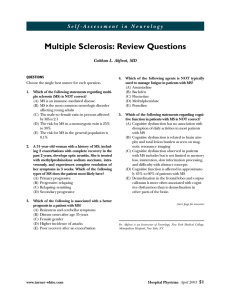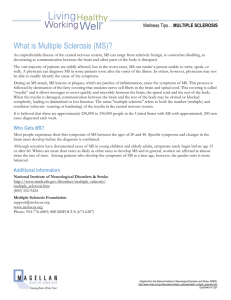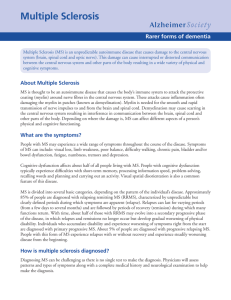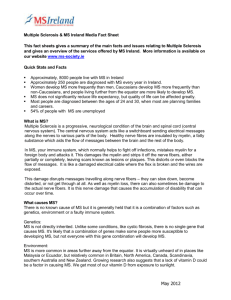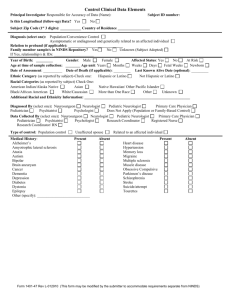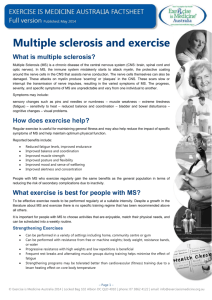Progressive
advertisement
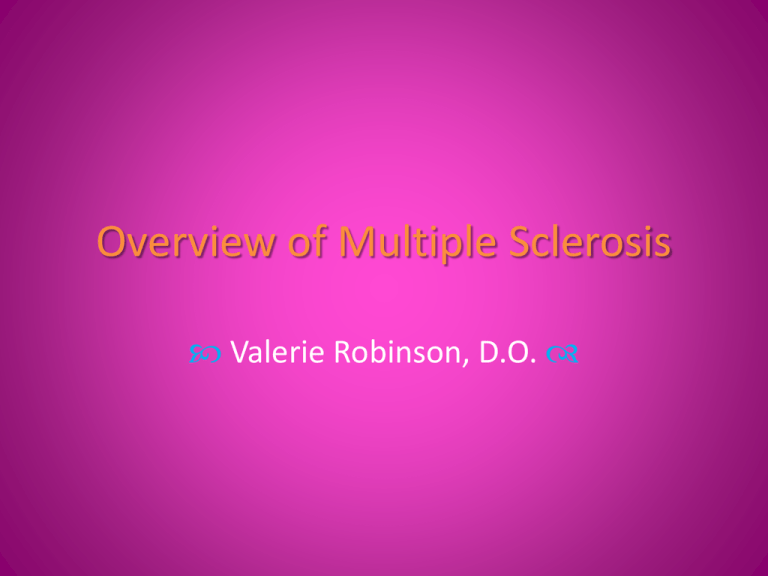
Overview of Multiple Sclerosis Valerie Robinson, D.O. What is it? • Multiple sclerosis is an inflammatory demyelinating disease, likely auto-immune. • Affects the CNS • Causes multifocal areas of demyelination • Most commonly affects women of childbearing age who are of Northern European descent. • There is a multiple-gene component • Siblings 3-5%, Twins 20-40% Signs and Symptoms • • • • • • • Relapses and Remissions Optic neuritis Internuclear opthomoplegia Sensory irregularities Pain Vertigo Muscle weakness, spasticity, paraparesis or paraplegia • Bowel/bladder/sexual dysfunction Signs and Symptoms • • • • • Fatigue Depression Cognitive dysfunction Difficulty with coordination McDonald’s criteria – multiple lesions are separated in space and time • Uhthoff’s phenomenon – worsening of symptoms when the body temp increases • Lhermitte’s sign – feeling of electric shock running down back and limbs upon neck flexion Diagnosis • Clinical judgment confirmed by the following: • MRI shows demyelinated plaques that meet McDonald’s criteria • CSF analysis: increased IgG, oligoclonal bands • Abnormal evoked potentials (visual, somatosensory, and brainstem auditory) • Onset between age 15 and 50 • Before 16 is considered pediatric = 5% Exacerbations/Relapses Acute neurologic impairment causing loss of function or severe discomfort. • Pregnancy, particularly 2-3 months postpartum • Stress • Random Types of MS • Relapsing-remitting (RRMS): clear relapses with full or partial recovery. No progression between relapses. • Primary-progressive (PPMS): From onset, disease progresses with occasional plateaus and temporary minor improvements. • Secondary-progressive (SPMS): Onset as RRMS then begins to progress. With or without relapses, minor improvements and plateaus. • Progressive-relapsing (PRMS): From onset, disease progresses. It has occasional clear relapses with full or partial recovery. Progression continues between relapses. Differential • • • • • • • • CVA/TIA Malignancy Spinal cord injury or compression A-V malformations Lupus Sjogren’s Cerebellitis Infections: such as meningitis, human Tlymphocytic virus type 1, HIV, syphilis Treatment of Progressive • Immunosuppression – – – – – – Azathioprine Cladribine Dalfampridine Glucocorticoids Cyclophosphamide Cyclosporine • Stem sell transplant – – – – – – Glatiramer acetate Interferon Methotrexate Mitoxantrone Natalizumab Rituximab • Total lymphoid irradiation Treatment of Relapsing • • • • • #1 Glucocorticoids Interferon Glatiramer acetate Natalizumab Plasma exchange if poor response to steroids • Methylprednisolone 1 gram IV QD x 3-7 days – Pediatric: 20-30 mg/kg QD x 5 days • May follow with a prednisone taper for residual disability References • Up-to-Date – Diagnosis of multiple sclerosis in adults – Epidemiology and clinical features of multiple sclerosis in adults – Treatment of progressive multiple sclerosis in adults – Treatment of acute exacerbations of multiple sclerosis in adults – Treatment of relapsing-remitting multiple sclerosis in adults – Treatment and prognosis of pediatric multiple sclerosis




